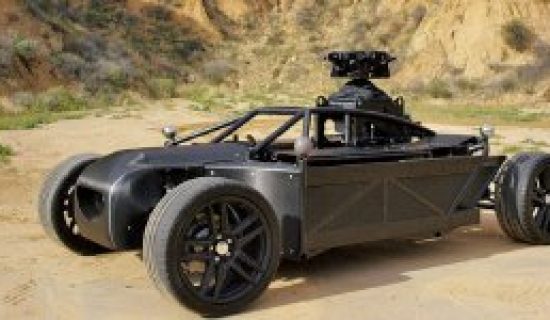August 7th, 2016 – Vince Bond Jr.
The pristine paint jobs consumers see in future car commercials could actually be the digitized skin of a virtual chameleon.
That’s because of an innovative vehicle called the Blackbird, a fully adjustable rig that can take the form of practically any car through computer-generated imagery and save automakers and their ad agencies precious time and money on shooting running footage.
The idea is for ad teams to roll out the Blackbird, shoot it driving down a picturesque highway one time, then add a layer of digital skin to it in the studio to match the car’s real-life looks, whatever they might be. And when that sedan gets a slight design update, like a new grille or taillight trim, the same footage can be tweaked through CGI.
Conceived by London-based visual-effects studio The Mill, the Blackbird was developed over two years and built by fabrication company J.E.M. F/X in a hangar where the Blackbird SR-71 supersonic reconnaissance jet was once assembled. The Blackbird name, The Mill says, is a “nod to this legacy of stealth design.”
But just how much sneakiness can automakers get away with?
Unless an ad calls for an outrageous, Hollywood-level stunt in which CGI is unavoidable, shouldn’t consumers have a right to see the real metal in commercials?
Ideally, yes, but budget constraints can make CGI an appealing option for agencies, says Scott Rodgers, co-founder of ad shop Tier10, which does regional work for several dealer groups such as the Northern Ohio Honda Dealers Association and the New York Acura Dealers Association.
Tier10 says it resorts to computerized cars only when it needs to place vehicles in graphical environments that the agency created.
“As technology evolves, you can pull this off, and people don’t know. Is it a morality question? I don’t know,” Rodgers told Automotive News, adding: “I want to say you should always use what you sell, but at the same time, the car itself starts in a virtual world [during design] anyway. To put it back into the virtual world, it’s all the same to me.”
The Mill — which has worked on campaigns for Audi, Dodge and Lincoln, among others — calls the Blackbird “a tool to solve real problems” for automotive advertisers, chief among them the cost and difficulty of keeping advertising as fresh and appealing as the products they build.
Costs can add up quickly for a shoot, especially when it comes to shipping vehicles, which can run as high as $3,000, not including expenses such as on-hand detailing crews to keep the cars clean.
The Mill said it designed the Blackbird so that its chassis length and width can be adjusted with the touch of a button. The rig’s camera system also captures its surroundings to generate accurate reflections.
The company is considering an off-road version as well, but with the current rig, “we stick to standard running footage on regular road surfaces,” a London-based spokeswoman for The Mill wrote in an email to Automotive News.
The Blackbird is grounded in realistic physics that makes for authentic vehicle depictions, said Steve Wright, a visual-effects expert who worked on such films as Ali, Batman & Robin and Air Force One.
“They’re not trying to trick or fool anybody,” Wright told Automotive News. “They’re trying to present the car as it really appears.”
Wright said auto advertising continues to become more Hollywood in its approach by using special effects that let creatives push the limits of their imagination.
“You’re trying to show your product in the sexiest way possible,” Wright said. “Trying to do it with live action can be not only difficult and expensive but impossible.”
But some marketing experts see risks in the technology, such as the temptation among advertisers to show cars doing things they aren’t capable of doing — cornering or off-road maneuvers, for example — even if it’s only in jest.
“The question mark for me is when, perhaps, the consumer sees the car performing in ways it really can’t, and it’s not clear that it’s not true,” Lara Koslow, a partner with the Boston Consulting Group, told Automotive News. “It’s that line of, “Can I tell that it’s just for fun?'”
Koslow, who has done research on the dynamics of marketing to millennials, says younger viewers tend to distrust big companies anyway. Even if they grew up on video games and over-the-top Hollywood effects, she says a CGI-enhanced commercial purporting to be real could backfire with that demographic if the illusion is pierced.
Indeed, online videos and articles about the Blackbird show a flood of comments from people questioning the ethics of using such a device in spots that are meant to sell physical products. The “false advertising” theme comes up often.
Keeping the illusion intact isn’t easy. When agencies shoot real vehicles over the course of several days, Tier10 says, they’ll likely run across unexpected subtleties with lighting, for instance, that they couldn’t get through CGI that add to the experience.
Tier10 creative team member Devin Leisher said some viewers might pick up on certain “micromovements” in CGI that take them out of the experience without them realizing it.
Besides, there’s beauty in authenticity, says Bill Daddi, president of Daddi Brand Communications, a New York marketing company. “Even in audio, people are moving back to analog and back to vinyl,” Daddi told Automotive News. “It’s not a series of ones and zeros. It’s a representation of authenticity, of reality. It’s filled with imperfections. Digital, as neat as it is, is going to be a series of ones and zeros.”

